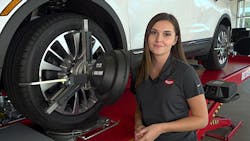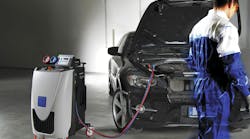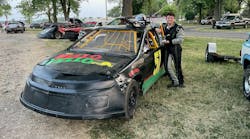Increasing the revenue-generating power of your shop by adding wheel alignment services doesn’t need to be complicated, time-consuming or expensive. You just have to think ahead.
- Your shop’s space limitations: One of the main reasons shops outsource wheel alignments is because they don’t have space to accommodate the large front-of-the-bay camera towers that are part of most alignment systems. In these situations, consider mobile alignment systems that don’t require these bulky towers, giving you back 5 to 8 feet of space at the front of the bay.
- Time-wasting processes: With some systems, technicians must perform the time-consuming and physically demanding process of rolling compensation in order to get an accurate alignment. This requires physically rolling the vehicle backward to allow the alignment head spindle to turn approximately 45 degrees and then rolling it forward. But there’s an easier, faster and safer way. Alignment equipment that uses advanced technology to eliminate the need for runout compensation will produce faster, accurate readings, increase productivity, and create a safer working environment.
- Signal reliability: Losing the signal on your cell phone is annoying. Losing the signal between the targets on a vehicle and the camera tower is costly because you can get inaccurate measurements or need to repeat the alignment process. Choosing a system that doesn’t need a tower eliminates the interference risk to ensure an accurate measurement the first time.
- How tall your techs are: Some alignment systems have height limits and can only be used when lifts are set at certain heights — which may not be the most ergonomic and productive heights for all the technicians in your shop. Choose equipment that anyone in your shop (now and in the future) can use comfortably.
- Your budget: Thanks to new players in the market, it’s no longer necessary to pay a premium price for a premium alignment system. Shop around to find the best deal on equipment that meets your specific needs.
- What kind of lift you want to use: Some alignment equipment can only be used with certain types of lifts, limiting your options. Look instead for a company that can provide a full range of lifts that are compatible with its alignment instrumentation, so you can get the best package available to maximize efficiency and profitability for your shop.
To learn more about how to get the best alignment equipment for your shop, download the free eBook at: info.rotarylift.com/adding-alignment. To learn more about Rotary alignment equipment, check out the video at rotarylift.com/Wheel-Service/Wheel-Alignment/, contact your local Rotary distributor or call (800) 640-5438. You can also find Rotary on Facebook, facebook.com/RotaryLift, Twitter, twitter.com/RotaryLift, and at The Blueprint blog, blog.rotarylift.com.
About Rotary
Rotary is the leading brand of vehicle lifts and wheel service equipment in North America. Rotary was founded in 1925 by the inventor of the first automotive hydraulic lift and now offers the broadest line of lifts and wheel service equipment for use in professional automotive service, commercial truck and transit applications. Its products include two-post, four-post, inground, scissor, mobile column, parallelogram, and platform lifts, as well as alignment lifts and instrumentation, tire changers, and wheel balancers.
Rotary is a Vehicle Service Group (VSG) brand. VSG is a strong, diverse and dynamic global leader in the vehicle service industry. It comprises 13 major vehicle lifting and collision repair brands: Rotary, Chief®, Forward®, Direct-Lift®, Revolution®, Hanmecson®, Ravaglioli, Elektron, Blitz, Nogra, Butler, Space and Sirio. With its American headquarters in Madison, Indiana, VSG has operations worldwide, including ISO 9001-certified manufacturing centers in the U.S., Europe and Asia.


